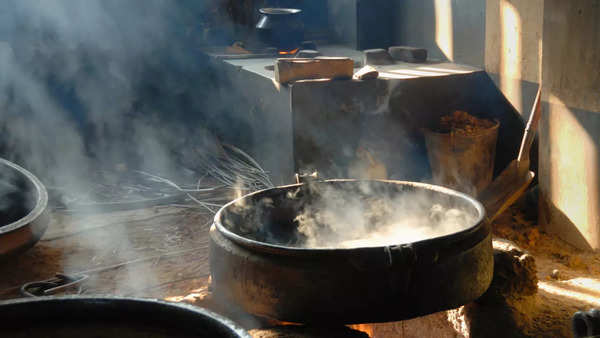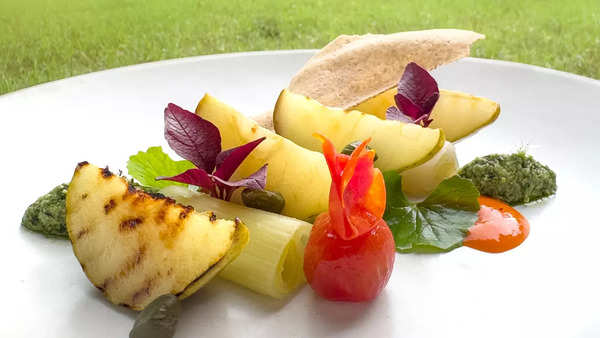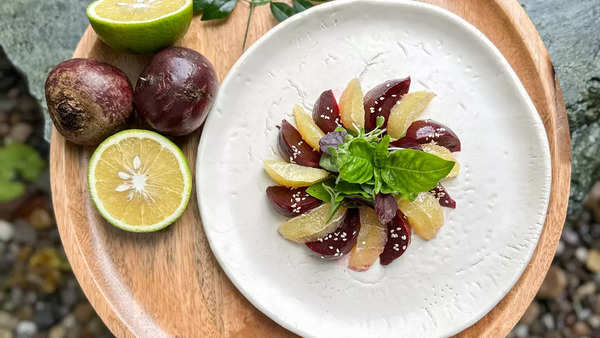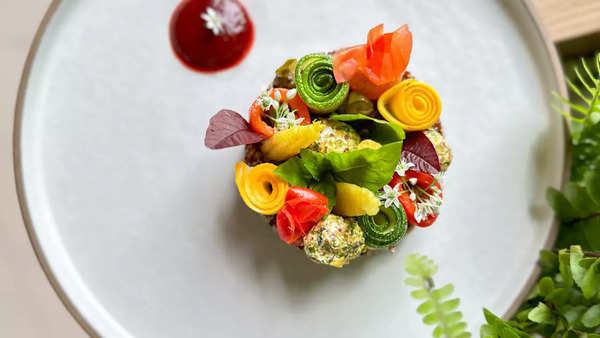Ayurvedic cooking is a key aspect of Ayurveda, focusing on preparing and consuming food in a way that promotes health, balance, and harmony.It’s not just about what you eat, but also how and when you eat. In Ayurveda, food is seen as medicine. The diet is tailored to balance an individual’s Doshas—Vata, Pitta, and Kapha. Vata-pacifying foods include warm, moist, and grounding foods like cooked grains, root vegetables, and healthy fats. Pitta-pacifying foods include cooling, hydrating foods like sweet fruits, leafy greens, and dairy. Kapha-pacifying foods include light, dry, and warm foods like legumes, bitter greens, and spices. Chef Rajesh Sharma, Director of Food & Beverage at Six Senses Vana, Dehradun, in an exclusive conversation with us talks about the Ayurvedic way of life and how to adopt it in daily cooking.
Also Read:9 food rules suggested by an Ayurveda expert to follow in changing weather
How to integrate Ayurvedic cooking in everyday food?
Ayurveda is one of the world’s oldest healing schools. It has been tested for thousands of years. Identifying the constitution of ‘doshas’ (bio energies – Vata, Pita, or Kapha) in one’s body is the first step towards integration in daily life. This is easily accomplished through a consultation with an Ayurvedic doctor. Following the consultation, one needs to follow a diet that pacifies a particular dosha, eg, Vata to have warm and grounding meals, Pita to have cooling and nourishing diet, and Kapha should enjoy a lighter and stimulating diet. Once this much work is completed, one must apply these concepts to their daily routine, or ‘dincharya’, as well as their life throughout the seasons, or ‘ritucharya’. The food around us changes with the seasons, and these variations are reflected in our metabolism. As a result, both systems must work together in harmony while keeping the body’s constitution in mind. All of this may seem difficult to grasp or follow at first, but with the aid of an Ayurvedic doctor/mentor, one will become more conscious about making the appropriate food choices.
Can daily food cooked with minimum spices be made tasty?
Ayurveda teaches us to create the right balance that suits our ‘dosha’ and to practice moderation. Even healthy foods can cause imbalance if consumed in excess. Practice moderation and variety in your diet. The reason for including spices in our daily diet is to improve digestion and extract maximum benefit of the food that we consume. While turmeric, ginger, black pepper, cumin, cinnamon, fennel, and coriander are considered as super spices other spices are used in combination with them. Some of the best ways to cook with spices in moderation include,
⦁ Layer Flavors: Start with whole spices like cumin seeds or mustard seeds in hot oil to release their aroma, then add ground spices to build deeper flavors.
⦁ Balance Spice with Sweetness: Adding a touch of sweetness, like honey or jaggery, can balance the heat from spices.
⦁ Use Fresh Spices: Freshly ground spices have more potency and flavor than pre-ground ones. Consider grinding your spices at home for the best taste.
⦁ Experiment with Spice Blends: Create your spice blends like garam masala or chai masala to have on hand for quick flavor boosts
What are some of the essential ingredients that are part of an Ayurvedic diet?
An Ayurvedic diet emphasizes balance, harmony, and nutrition, using foods and spices that support the body’s natural rhythms and constitution. The essential ingredients may include, whole grains and millets, legumes, herbs and spices, seasonal vegetables and fruits, dairy products (like ghee, yogurt & milk), nuts and seeds, oils, sweeteners, and herbal teas.
How to prepare a meal to get max nutrients from veggies?
Ayurveda emphasizes that the way food is prepared and cooked can greatly influence its nutritional value and how well it is assimilated by the body. Some of the techniques to maximize the nutritional benefits are steaming, blanching, grilling, sautéing with ghee, marinating, using seasonal produce, using herbs and spices or spice blends, and fermenting.
Also Read: Ayurveda inspired food tips to stay healthy

You have mastered different healthy cooking styles. Tell us about them.
The Ayurvedic cuisine changes with each of the five seasons (summer, monsoon, autumn, winter, spring) and remains ever-evolving even after 10 years of its inception. Our style of cooking includes:
⦁ Slow cooking- Cooking legumes and root vegetables at low temperatures in heavy bottom utensils inside an over or a direct flame with a lid helps in breaking the fiber, making them easier to digest and developing more complex flavours.
⦁ Fermentation- Indian pickles (amla, cauliflower, lime, mango) sauerkrauts – made with white cabbage and turmeric, red cabbage and cumin | Beverages- kombucha, kefir, coconut yogurt, tepache, ginger beer. Miso paste made with chana dal and kabuli chana. Tempeh made with local rajma. The properties, flavor profile and overall characteristics of an ingredient change with fermentation.
⦁ Minimalistic cooking- Lightly cooking vegetables preserves their natural enzymes, which can aid digestion. Overcooking can destroy these enzymes and reduce nutrient content.
Share your 3 favorite salad recipes.
Grilled pear and leek salad, basil-pesto, mesclun

Ingredients
2 large-sized pears, cut into wedges, grilled
4 leeks(white part only), boiled for 10-12 minutes
2 tbsp balsamic vinegar
4 tbsp extra-virgin olive oil
1 cup mesclun (mixed salad greens)
2 tbsp basil pesto
Gluten-Free Crackers
salt and pepper to taste
Method
⦁ Heat an iron griddle on a very high flame and grill the wedges of pears until lightly charred. Sprinkle a few drops of olive oil. Season.
⦁ Cool the leeks and cut into 2-inch-long sticks. On a medium hot pan, grill the leeks until slightly charred.
⦁ Now in a mixing bowl pour balsamic vinegar, the remaining quantity of EVOO, salt, and pepper, and whisk it well.
⦁ In a pasta bowl, arrange the pears and leeks in a nice pattern. Sprinkle the dressing over the mesclun and place them on top. Serve pesto and gluten-free crackers along with the salad.
Beetroot and Sweet Lime Salad, Mesclun, Toasted Sesame

Ingredients
⦁ 4 medium-sized beetroot boiled and peeled
⦁ Bunch of assorted lettuce refreshed
⦁ 18-20 nos. orange or sweet lime segments
⦁ 1 tbsp. feta cheese crumbled
⦁ Pinch black pepper crushed
⦁ A pinch of sea salt
⦁ 3 tbsp. vinaigrette
⦁ 1 tsp toasted sesame seeds
⦁ Micro greens for garnish.
Method
⦁ Arrange the prepared lettuce in a chilled serving bowl.
⦁ Cut the beetroot into 1×8 wedges. Take the beetroot in a bowl, add half of the vinaigrette, and mix nicely.
⦁ Place the marinated beetroot wedges around the lettuce, add sweet lime or orange segments, and sprinkle with crumbled feta cheese on top.
⦁ Adjust the seasoning by adding salt and pepper. Drizzle rest of the vinaigrette over the salad leaves and garnish with toasted sesame seeds and micro greens.
Orange Vinaigrette
Ingredients
⦁ 3/4 cup extra-virgin olive oil
⦁ 1/4 cup orange juice
⦁ 2 tsp brown sugar
⦁ 1 tsp mustard paste
⦁ Salt to taste
⦁ Pepper to taste
Method
⦁ 1. Place all the ingredients in a blender and mix for about 10 seconds or until fully combined.
⦁ 2. Transfer to a bowl and rest for 30 minutes to let the flavors meld.
⦁ 3. Give the dressing a good whisk before serving.
Red Quinoa Salad, Labneh, Mesclun

Ingredients
¼ cup white quinoa
¼ cup red quinoa
½ tsp lemon zest
2 tbsp extra-virgin olive oil
1 tbsp parsley, chopped
1 tsp lime juice
½ piece green zucchini
½ piece yellow zucchini
½ cherry tomato
¼ cup hung yogurt
½ tsp za’atar spice mix
½ cup mesclun (mixed)
salt and pepper to taste
Method
1. Wash and clean the quinoa and then soak it for 10 minutes in warm water. Put the soaked quinoa in a pan, add double the quantity of water, and cook the soaked grain until the grain starts to burst with a covered lid.
2. Slice the zucchini into ¼ cm thick ribbons, and grill them over a medium-hot pan until slightly brown, sprinkle extra virgin olive oil. Season. Roll them into pinwheels
3. Heat a separate pan over high heat and add cherry tomatoes to it, cook the tomatoes for 60 to 90 seconds or until blistered, and sprinkle a few drops of EVOO. Season.
4. In a bowl, mix the hung yogurt and zatar spice well. Apply a few drops of EVOO on your palm and divide the yogurt into tiny spheres to make labneh balls.
4. In a mixing bowl, add quinoa, lemon zest, lemon juice, chopped parsley, EVOO, and mix well. Add seasoning. With the help of a 3-inch diameter cookie cutter, mold the quinoa salad on a plate into a thick round disc.
5. Arrange the zucchini pinwheels, tomatoes, labneh balls, and mesclun on top of the quinoa salad.










